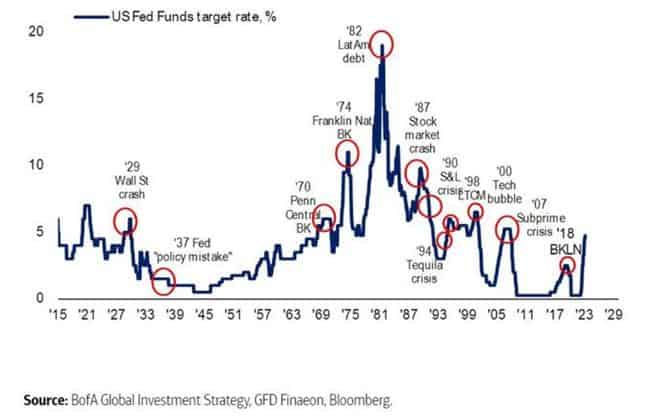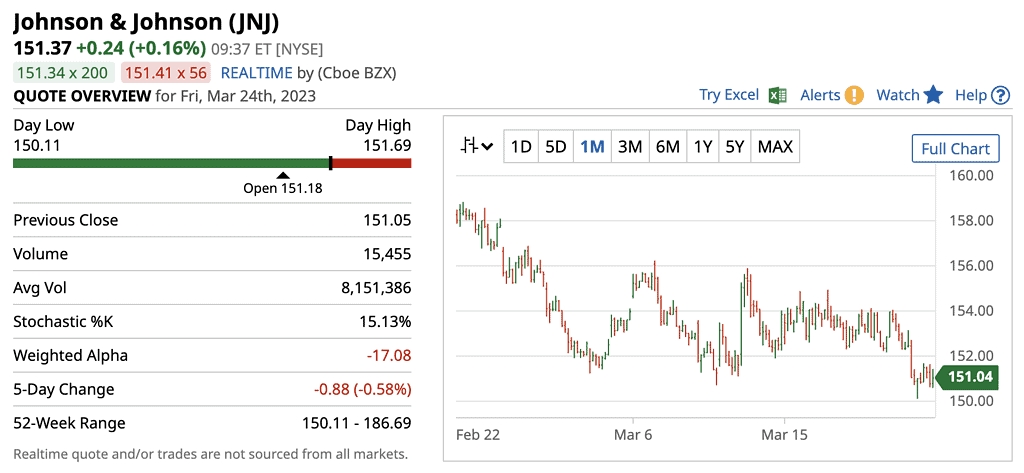Study Shows 186 Banks Are On The Brink Of Failure

Image Source: Pexels
The Fed has done it again: raised their interest rates for the 9th time on March 22, 2023, by 25 basis points. This brings the fed fund rate to 4.75%-5%. However, this move sent mixed signals to investors after the banking turmoil resulting from the collapse of Silvergate Capital, Silicon Valley Bank, Signature Bank, and Credit Suisse. Investors view continuous rate hikes as one of the main drivers of these recent collapses.

Source: BofA Global Investment Strategy
The chart above suggests that Fed hiking cycles tend to end in a crisis - each and every time. The charts also show that the Fed could not achieve a similar rate before or above the previous cycle after the Lat Am debt crisis. In addition, the chart suggests that crises tend to arise when Fed Fund Rates go up to 50-80% of their immediately preceding peak.
With the above chart in mind, investors’ sentiment has been divided as the high-interest rate environment is believed to be one of the major causes of the current banking turmoil that is slowly affecting other regions too. A recent study by Social Science Network’s study states that roughly 186 banks are at risk of collapsing, similar to SVB, if a bank run (a bank run is the sudden withdrawal of deposits of just one bank) happens again and concludes that FDIC would run out of money to pay guaranteed deposits.
This increased fear has also influenced observers to urge the central bank to pause its rate hikes or at least assess the fallout from SVB and Signature bank. Weeks before the hike and the collapse, Fed Chair Jerome Powell had cautioned Fed watchers that the U.S. central bank was willing to speed up how much it is hiking interest. Their statement mentioned that “Some policy firming may be appropriate,” suggesting a stance change to a weaker commitment to tightening credit.
How does this affect you?
With the Fed’s continued fight to slow down inflation continues; a potential rate hike can still occur even with the shift in the Fed’s tone. If so, investors should expect the cost of borrowing to keep increasing throughout the year once the Fed continues to raise interest rates again. This will potentially drive up the cost of auto financing, credit card debt, and loans. Interest rates on loans have nearly doubled in the last year and increased the burden on consumers who bear the brunt of the high inflation. Stock Investors are also affected as tightening policies aim to reduce liquidity and slow down growth, which affects company earnings estimates and adds volatility to the market.
What can you do?
With the looming fear of continued collapse, rising inflation, and a potential recession, investors should always look at investing in lower-risk assets like Treasury Bills (Liquid debt securities backed by the government), investment-grade corporate bonds (can help mitigate interest rate risk by selecting bonds that are from large and reputable companies), or Dividend Paying Stocks (provide a stable income when investing in high-quality stocks like those in Dividend Kings and Dividend Aristocrats).
Why dividend stocks in a rising interest rate environment?
Higher interest rates mean that dividend yields on stocks are under pressure. The companies need to boost dividends to maintain the same relative payout level. The same problem happens with bonds – as rates go up, bond values drop. But why invest in dividend stocks now? Some sectors prosper in a rising rate environment. For example, Consumer Staples remain steady in a high-interest rate environment as the demand for staples like groceries, healthcare, and other necessities are not cut back regardless of the market environment.
Investors should always look at companies with healthy financials and a long history of weathering economic downturns and continuously increasing their dividends.
Let’s look at Johnson & Johnson.
Johnson & Johnson (JNJ)
(Click on image to enlarge)

Johnson & Johnson is a multinational corporation based in New Brunswick, NJ, that manufactures and sells health-related products and services. It is also one of the world's most valuable corporations, employing more than 140,000 active employees. JNJ's operations are segmented into three groups:
- Consumer Health: Provides products based on science and approved by medical
experts to help people improve their health.
- MedTech: Diverse healthcare expertise and purposeful, innovative technology help save lives and aim to create a future where healthcare solutions are smarter, less intrusive, and more personalized in surgery, orthopedics, and interventional solutions.
- Pharmaceutical: Products distributed through the Janssen Pharmaceutical Companies. Janssen envisions a future in which disease prevention, early detection, treatment, and cure will change thanks to its cutting-edge biologics and other medical components.
JNJ's annual dividend yield is 4.52% which is rare for a dividend stock of this size. JNJ has a 5-year dividend growth of 34.04%. JNJ has been continuously increasing its dividend for 61 years. The company is both a Dividend Aristocrat and Dividend King. Based on JNJ's
historical announcements, their next dividend announcement should be around the 2nd-3rd week of April.
How Johnson & Johnson Weathered Previous Crises
Johnson & Johnson survived various financial crises by diversifying its products and focusing on research and development that will help communities in the long run. During the Great Depression, the JNJ introduced a line of baby products, which proved to be a huge success. In the 1970s, when the oil crisis caused a recession, JNJ diversified into pharmaceuticals, which helped it weather the storm. And during the dot-com bubble, it continued to invest in research and development and focus on its core business which helped it stay ahead of the competition.
Final Thoughts
Navigating the current market environment has been very tough for most investors. Rising inflation, tightening policies, the looming threat of recession, and the sudden bank collapses have put investors on edge and suggest that we are not out of the woods - yet. However, with a potential last leg of the tightening cycle, we may see the light at the end of the tunnel.
More By This Author:
10 Most Oversold Stocks To Buy In August 2022
19 Dividend Stocks That Pay In February, May, August And November
This Is How To Make $1000/mo In Passive Income With Dividend Stocks
Disclaimer: The information in this article is for informational and entertainment purposes only and does not constitute financial, accounting, or legal advice. By reading anything in this ...
more


